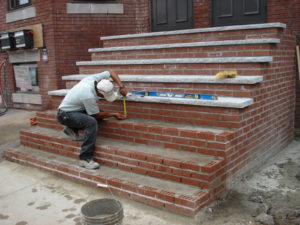
Many people look to repair masonry work themselves. The idea here is usually to save the time, hassle, and cost of bringing in a professional mason to conduct the repairs.
But DIY masonry is not as easy as it looks. Because each brick or stone is individually placed and filled with mortar, the skill of masonry is one that takes years to perfect. Hiring a reputable specialist not only puts your mind at ease — it guarantees that your home or other brickwork will be brought back to its quality shape.
If you are wondering what exactly your pavement specialist will do, here are the general steps for the basic repair on masonry, whether it’s a wall, chimney or similar structure.
Repairing Damaged Mortar
Step 1: Grinding and removing crumbling mortar
For a good number of masonry repairs, the first step is tuckpointing. In this process, an angled grinder is used to loosen the crumbling mortar, and a hammer drill is employed in order to knock the mortar out. After the joints have been swept and cleaned out with water, your pavement specialist will begin to prepare the new mortar to fill in the joints.
Step 2: Setting the mortar
The mortar is then pushed and worked into the joints between the bricks or stones using a tool called a trowel. A jointer will also be used if the lines of mortar are to be rounded. After the mortar has had a chance to dry, the bricks and mortar will be wiped down with a brush to create a clean finish.
These steps describe how to fix cracked mortar, but what will they do if the brick itself is cracked? First, bricks vary greatly in size and color — so they will have to match the new bricks exactly with the existing ones.
Repairing Damaged Bricks
Step 1: Removing bricks
To remove the damaged bricks, a professional mason will use hammer and chisel or a power tool to break and remove the brick by pieces. They will then clean the old mortar away, taking care not to damage any of the other bricks in the surrounding area.
Step 2: Replacing damaged brick
Once a clean void has been created, the new brick is ready to slide in. The mortar is mixed and placed beneath or behind the new brick, and the mortar is filled around the new brick by using tools similar to the ones described in the first scenario.
Should I repair masonry myself?
This depends on your personal experience and aptitude with masonry work — but in general, professional helps is a much better bet. When you look for someone to do your masonry repair work, choose wisely. Only take advice from a specialist who has the requisite experience and skill, and the quality of your results will show.
